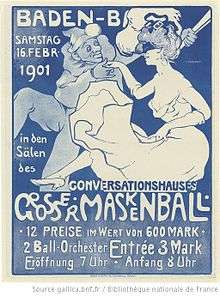Ivo Puhonny
Ivo Puhonny (19 July 1876 – 6 February 1940)[1] was a German graphic artist and puppeteer, son of the landscape painter Victor Puhonny. Puhonny is known primarily for his advertising art in the Sachplakat style, and the creation of the Baden-Baden Puppet Theater in 1911.[2][3][4]
Ivo Puhonny | |
|---|---|
| Born | 19 July 1876 |
| Died | 6 February 1940 (aged 63) |
| Nationality | German |
| Occupation | Graphic artist, illustrator, puppeteer |
| Known for | Sachplakat movement, puppet theaters |

Life and work
Graphics
Puhonny studied at the Art Academy in Karlsruhe, and was influenced by the work of Henri de Toulouse-Lautrec.[4] Involved in the poster art movement of the early 20th century, Phuonny created advertisements for products such as margarine (for Schlinck & Co.)[5] and cigarettes (Batschari).[4][6] He also illustrated books[7] and created etchings and lithographs. His graphics work is preserved in the Museum of Arts and Crafts in Hamburg and the Gallica Bibliothèque Numérique of the Bibliothèque nationale de France.[8]
Puppetry
In 1911 he founded the Baden-Baden Künstler-Marionettentheater, dedicated to puppet performances.[9] Puhonny and his wife carved and clothed the puppets and designed the stages for the plays. The theatre was based in Baden-Baden during the winter, and went on tour during the summers. Many of his puppet dolls are displayed in the collection of the Munich City Archives and the Staatliche Kunstsammlungen Dresden.[10]
Personal life
.jpg)
Puhonny married his school sweetheart Lisa, with whom he had two daughters, Eva and Doris. His home in Baden-Baden was a gathering place for important artists of the time, including Else Lasker-Schüler, Otto Flake, Klabund and Carl Sternheim. Puhonny was prone to depression because of his experiences during World War I, and the emergence of Nazism affected him due to his foreign-sounding name and the socially critical nature of his work, which became increasingly sidelined after World War II began. His circle of friends and acquaintances included Jews whose emigration, deportation and suicides exacerbated his depression. Suffering from a nervous disorder, he died at a sanatorium in Stuttgart following a stroke.[4]
Notes
- "Ergebnis der Suche nach: Ivo Puhonny" (in German). Deutschen Nationalbibliothek. Retrieved 8 December 2012.
- Ciarlo, p. 280
- Popular Mechanics, p. 359
- Wettstein, Rika. "Ivo Puhonny (1876-1940)" (in German). BADEN-BADEN der ultimative Stadtführer. Retrieved 7 December 2012.
- Ciarlo, p. 303
- "A. Batschari Cigarettenfabrik, Baden Baden, Germany". tincollectors.nl. Retrieved 8 December 2012.
- Library of Congress Copyright Office, p. 985 - "The rajah's people, by I.A.R. Wylie; with three illustrations by Ivo Puhonny"
- "Baden-Baden, Samstag 16 Febr. 1901 Conversationshauses Grosser Maskenball / Ivo Puhonny" (in French). Gallica Bibliothèque Numérique. Retrieved 7 December 2012.
- Sachs, p. 27
- "Herr Steinreich aus "Doktor Sassafras oder Doktor, Tod und Teufel"" (in German). Staatliche Kunstsammlungen Dresden. Retrieved 30 April 2019.
Bibliography
- Ciarlo, David (2011). Advertising Empire: Race and Visual Culture in Imperial Germany. Volume 171 of Harvard Historical Studies. Harvard University Press. ISBN 9780674050068. Retrieved 2012-12-07.
- "Plays by marionettes prove popular in Germany". Popular Mechanics. Hearst Magazines. 55 (3). March 1931. ISSN 0032-4558. Retrieved 2012-12-07.
- Catalogue of Copyright Entries: Books, Volume 7, Issue 2. orig. the University of Harvard. Library of Congress. Copyright Office. 1910.CS1 maint: others (link)
- Sachs, Harvey; Manildi, Donald (1995). Rubinstein: A Life in Music. Grove Press. ISBN 9780802115799. Retrieved 2012-12-07.
Further reading
- Puhonny, Ivo (1919). Ivo Puhonny's Künstler-Marionettentheater.
- Puhonny, Ivo (July 30, 1919). "Vom deutschen Puppenspiel". Frankfurter Zeitung (in German). 30 (557). Retrieved 2012-12-07.
- Engert, Joachim O. (2009). Genre- und Landschaftsmaler Victor Puhonny: Prag 1838 - 1909 Baden-Baden ; Biographie und Werkverzeichnis. Künstler in Baden-Baden 2009 (in German). Ancien-Grafik. ISBN 9783000270451. Retrieved 2012-12-07.
Material below compiled from Gamble, William Burt (2009). The development of scenic art and stage machinery: a list of references in the New York public library. University of Michigan. New York Public Library.
- Hirsch, Gilbert (April 29, 1916). "A master of marionettes". Harper's Weekly (v. 62): 475–476.
- Puhonny, Ivo (1913). "Vom Puppentheater". Geleitworte (in German). Mannheim (4): 47–49.
External links
| Wikimedia Commons has media related to Ivo Puhonny. |